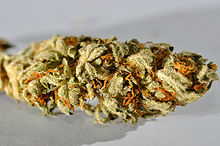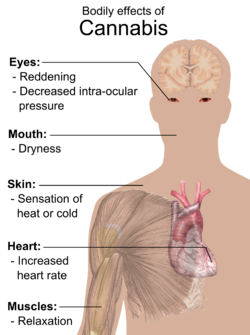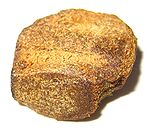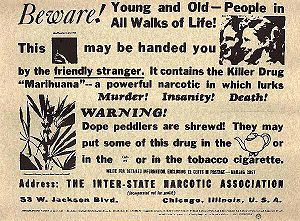- Cannabis (drug)
-
"Marijuana" redirects here. For other uses, see Marijuana (disambiguation).For the plant genus, see Cannabis.
Cannabis Dried flowers from the Cannabis sativa plant with visible trichomes. Scientific classification Kingdom: Plantae Phylum: Magnoliophyta Class: Magnoliopsida Order: Rosales Family: Cannabaceae Genus: Cannabis Species: C. sativa Binomial name Cannabis sativa L.[1]
Cannabis indica Lam. (putative)[1]
Cannabis, also known as marijuana[2] (sometimes spelled "marihuana"[3]) among many other names,a[›] refers to any number of preparations of the Cannabis plant intended for use as a psychoactive drug or for medicinal purposes. The English term marijuana comes from the Mexican Spanish word marihuana.[4] According to the United Nations, cannabis "is the most widely used illicit substance in the world."[5]
The typical herbal form of cannabis consists of the flowers and subtending leaves and stalks of mature pistillate female plants. The resinous form of the drug is known as hashish (or merely as 'hash').[6]
The major psychoactive chemical compound in cannabis is Δ9-tetrahydrocannabinol (commonly abbreviated as THC). Cannabis contains more than 400 different chemical compounds, including at least 66 other cannabinoids (cannabidiol (CBD), cannabinol (CBN) and tetrahydrocannabivarin (THCV), etc.) which can result in different effects from those of THC alone.[7]
Documented instances of cannabis use go back as far as the 3rd millennium BC.[8] In modern times, the drug has been used for recreational, religious or spiritual, and medicinal purposes. The UN estimated that in 2004 about 4% of the world's adult population (162 million people) use cannabis annually, and about 0.6% (22.5 million) use it on a daily basis.[9] The possession, use, or sale of cannabis preparations containing psychoactive cannabinoids became illegal in most parts of the world in the early 20th century.[10]
Contents
Effects
Main article: Effects of cannabisCannabis has psychoactive and physiological effects when consumed. The minimum amount of THC required to have a perceptible psychoactive effect is about 10 micrograms per kilogram of body weight.[11] Aside from a subjective change in perception and, most notably, mood, the most common short-term physical and neurological effects include increased heart rate, lowered blood pressure, impairment of short-term and working memory,[12] psychomotor coordination, and concentration. Long-term effects are less clear.[13][14]
Classification
Main article: Psychoactive effectsWhile many drugs clearly fall into the category of either stimulant, depressant, or hallucinogen, cannabis exhibits a mix of all properties, perhaps leaning the most towards hallucinogenic or psychedelic properties, though with other effects quite pronounced as well. Though THC is typically considered the primary active component of the cannabis plant, various scientific studies have suggested that certain other cannabinoids like CBD may also play a significant role in its psychoactive effects.[15][16][17]
Medical use
Main article: Medical cannabisCannabis used medically does have several well-documented beneficial effects. Among these are: the amelioration of nausea and vomiting, stimulation of hunger in chemotherapy and AIDS patients, lowered intraocular eye pressure (shown to be effective for treating glaucoma), as well as general analgesic effects (pain reliever).b[›]
Less confirmed individual studies also have been conducted indicating cannabis to be beneficial to a gamut of conditions running from multiple sclerosis to depression. Synthesized cannabinoids are also sold as prescription drugs, including Marinol (dronabinol in the United States and Germany) and Cesamet (nabilone in Canada, Mexico, the United States and the United Kingdom).b[›] In 2011, an oromucosal spray for Multiple Sclerosis patients became licensed for use as a medicine from the European regulatory body, allowing it to be routinely prescribed by doctors.[18]
Currently, the U.S. Food and Drug Administration (FDA) has not approved smoked marijuana for any condition or disease in the United States, largely because good quality scientific evidence for its use from U.S. studies is lacking; however, a major barrier to acquiring the necessary evidence is the lack of federal funding for this kind of research.[19] Regardless, fourteen states have legalized cannabis for medical use.[20][21] The United States Supreme Court has ruled in United States v. Oakland Cannabis Buyers' Coop and Gonzales v. Raich that it is the federal government that has the right to regulate and criminalize cannabis, even for medical purposes. Canada, Spain, The Netherlands and Austria have legalized some form of cannabis for medicinal use.[22]
Long-term effects
Main article: Long-term effects of cannabisMain article: Cannabis smoking#Smoking lung cancer risk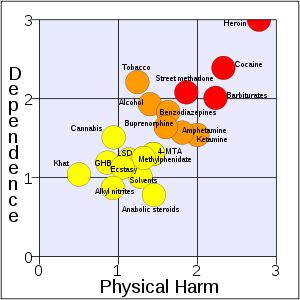 Cannabis is ranked one of the least harmful drugs by a study published in the UK medical journal, The Lancet.[23]
Cannabis is ranked one of the least harmful drugs by a study published in the UK medical journal, The Lancet.[23]
Though the long-term effects of cannabis have been studied, there remains much to be concluded. Debated aspects include the possibility of cannabis dependence, the potential of cannabis as a "gateway drug", its effects on intelligence and memory, and the relationship, if any, of cannabis use to mental disorders such as schizophrenia and depression.[24][25][26] On some topics, such as the drug's effects on the lungs, relatively little research has been conducted, leading to division as to the severity of its impact.
While cannabis has been correlated with the development of various mental disorders in multiple studies, these studies differ widely as to whether cannabis use is the cause of the mental problems, whether the mental problems encourage cannabis use, or whether both the cannabis use and the mental problems are the effects of some other cause. Similarly, experiments regarding the "gateway drug" hypothesis that cannabis and alcohol make users more inclined to become addicted to "harder" drugs like cocaine and heroin have produced mixed results, with different studies finding varying degrees of correlation between the use of cannabis and other drugs, and some finding none.[citation needed] Generally, no scientific consensus exists regarding many of cannabis's long-term effects, despite a large number of studies.
However, cannabis has been consistently shown to induce depersonalization disorder [27]. There are case reports in the literature where chronic depersonalization is induced by only short-term cannabis ingestion [28][29]. In a series of 117 individuals with depersonalization disorder, about 13% reported the short-term triggering of chronic depersonalization by marijuana smoking [30] . There are cases where individuals have gotten depersonalization disorder when trying cannabis for the first time. Chronic depersonalization disorder can last an entire lifetime, and to date there are no specific medical treatments (just medications which ameliorate the negative symptoms of depersonalization disorder, which are mainly depression and anxiety), although some research has been promising [31]
Forms
Unprocessed
 Dried Cannabis flowers in natural herbal form
Dried Cannabis flowers in natural herbal form
The terms cannabis or marijuana generally refer to the dried flowers and subtending leaves and stems of the female cannabis plant.[citation needed] This is the most widely consumed form, containing 3% to 22% THC.[32][33] In contrast, cannabis strains used to produce industrial hemp contain less than 1% THC and are thus not valued for recreational use.[34]
Processed
Kief
Main article: KiefKief is a powder, rich in trichomes, which can be sifted from the leaves and flowers of cannabis plants and either consumed in powder form or compressed to produce cakes of hashish.[35]
Hashish
Main article: HashishHashish (also spelled hasheesh, hashisha, or simply hash) is a concentrated resin produced from the flowers of the female cannabis plant. Hash can often be more potent than marijuana and can be smoked or chewed.[36] It varies in color from black to golden brown depending upon purity.
Hash oil
Main article: Hash oilHash oil, or "butane honey oil" (BHO), is a mix of essential oils and resins extracted from mature cannabis foliage through the use of various solvents. It has a high proportion of cannabinoids (ranging from 40 to 90%).[37] and is used in a variety of cannabis foods.
Residue (resin)
Because of THC's adhesive properties, a sticky residue, most commonly known as "resin", builds up inside utensils used to smoke cannabis. It has tar-like properties but still contains THC as well as other cannabinoids. This buildup retains some of the psychoactive properties of cannabis but is more difficult to smoke without discomfort caused to the throat and lungs. This tar may also contain CBN, which is a breakdown product of THC. Cannabis users typically only smoke residue when cannabis is unavailable. Glass pipes may be water-steamed at a low temperature prior to scraping in order to make the residue easier to remove.[38]
Routes of administration
Main article: Cannabis consumption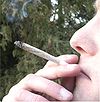 A joint
A joint
Cannabis is consumed in many different ways, most of which involve inhaling vaporized cannabinoids ("smoke") from small pipes, bongs (portable version of hookah with water chamber), paper-wrapped joints or tobacco-leaf-wrapped blunts.
A vaporizer heats herbal cannabis to 365–410 °F (185–210 °C), causing the active ingredients to evaporate into a vapor without burning the plant material (the boiling point of THC is 390.4 °F (199.1 °C) at 760 mmHg pressure).[39] A lower proportion of toxic chemicals is released than by smoking, depending on the design of the vaporizer and the temperature setting. This method of consuming cannabis produces markedly different effects than smoking due to the flash points of different cannabinoids; for example, CBN (usually considered undesirable) has a flash point of 212.7 °C (414.9 °F)[40] and would normally be present in smoke but not in vapor.
Fresh, non-dried cannabis may be consumed orally. However, the cannabis or its extract must be sufficiently heated or dehydrated to cause decarboxylation of its most abundant cannabinoid, tetrahydrocannabinolic acid (THCA), into psychoactive THC.[41]
Cannabinoids can be extracted from cannabis plant matter using high-proof spirits (often grain alcohol) to create a tincture, often referred to as Green Dragon.
Cannabis can also be consumed as a tea. THC is lipophilic and only slightly water-soluble (with a solubility of 2.8 mg per liter),[42] so tea is made by first adding a saturated fat to hot water (i.e. cream or any milk except skim) with a small amount of cannabis.
Mechanism of action
The high lipid-solubility of cannabinoids results in their persisting in the body for long periods of time. Even after a single administration of THC, detectable levels of THC can be found in the body for weeks or longer (depending on the amount administered and the sensitivity of the assessment method). A number of investigators have suggested that this is an important factor in marijuana's effects, perhaps because cannabinoids may accumulate in the body, particularly in the lipid membranes of neurons.[43]
Until recently, little was known about the specific mechanisms of action of THC at the neuronal level. However, researchers have now confirmed that THC exerts its most prominent effects via its actions on two types of cannabinoid receptors, the CB1 receptor and the CB2 receptor, both of which are G-Protein coupled receptors. The CB1 receptor is found primarily in the brain as well as in some peripheral tissues, and the CB2 receptor is found exclusively in peripheral tissues.[44] THC appears to alter mood and cognition through its agonist actions on the CB1 receptors, which inhibit a secondary messenger system (adenylate cyclase) in a dose dependent manner. These actions can be blocked by the selective CB1 receptor antagonist SR141716A (rimonabant), which interestingly has been shown in clinical trials to be an effective treatment for smoking cessation, weight loss, and as a means of controlling or reducing metabolic syndrome risk factors.[45]
Potency
According to the United Nations Office on Drugs and Crime (UNODC), "the amount of THC present in a cannabis sample is generally used as a measure of cannabis potency."[46] The three main forms of cannabis products are the herb (marijuana), resin (hashish), and oil (hash oil). The UNODC states that marijuana often contains 5% THC content, resin "can contain up to 20% THC content", and that "Cannabis oil may contain more than 60% THC content."[46]
A scientific study published in 2000 in the Journal of Forensic Sciences (JFS) found that the potency (THC content) of confiscated cannabis in the United States (US) rose from "approximately 3.3% in 1983 and 1984", to "4.47% in 1997". It also concluded that "other major cannabinoids (i.e., CBD, CBN, and CBC)" (other chemicals in cannabis) "showed no significant change in their concentration over the years".[47] More recent research undertaken at the University of Mississippi's Potency Monitoring Project[48] has found that average THC levels in cannabis samples between 1975 and 2007 have increased from 4% in 1983 to 9.6% in 2007.
Australia's National Cannabis Prevention and Information Centre (NCPIC) states that the buds (flowers) of the female cannabis plant contain the highest concentration of THC, followed by the leaves. The stalks and seeds have "much lower THC levels".[49] The UN states that the leaves can contain ten times less THC than the buds, and the stalks one hundred times less THC.[46]
After revisions to cannabis rescheduling in the UK, the government moved cannabis back from a class C to a class B drug. A purported reason was the appearance of high potency cannabis. They believe skunk accounts for between 70 and 80% of samples seized by police [50] (despite the fact that skunk can sometimes be incorrectly mistaken for all types of herbal cannabis).[51][52] Extracts such as hashish and hash oil typicality contain more THC than high potency cannabis flowers.
While commentators have warned that greater cannabis "strength" could represent a health risk, others have noted that users readily learn to compensate by reducing their dosage, thus benefiting from reductions in smoking side-hazards such as heat shock or carbon monoxide.
Adulterants
Chalk (in the Netherlands) and glass particles (in the UK) have been used to make cannabis appear to be higher quality.[53][54][55] Increasing the weight of hashish products in Germany with lead caused lead intoxication in at least 29 users.[56] In the Netherlands two chemical analogs of Sildenafil (Viagra) were found in adulterated marijuana.[57]
According to both the "Talk to FRANK" website and the UKCIA website, Soap Bar, "perhaps the most common type of hash in the UK", was found "at worst" to contain turpentine, tranquilizers, boot polish, henna and animal feces—amongst several other things.[58][59] One small study of five "soap-bar" samples seized by UK Customs in 2001 found huge adulteration by many toxic substances, including soil, glue, engine oil and animal feces.[60]
Detection of use
THC and its major (inactive) metabolite, THC-COOH, can be quantitated in blood, urine, hair, oral fluid or sweat using chromatographic techniques as part of a drug use testing program or a forensic investigation of a traffic or other criminal offense. The concentrations obtained from such analyses can often be helpful in distinguishing active use from passive exposure, prescription use from illicit use, elapsed time since use, and extent or duration of use. These tests cannot, however, distinguish authorized cannabis smoking for medical purposes from unauthorized recreational smoking.[61] Commercial cannabinoid immunoassays, often employed as the initial screening method when testing physiological specimens for marijuana presence, have different degrees of cross-reactivity with THC and its metabolites. Urine contains predominantly THC-COOH, while hair, oral fluid and sweat contain primarily THC. Blood may contain both substances, with the relative amounts dependent on the recency and extent of usage.[61][62][63][64]
The Duquenois-Levine test is commonly used as a screening test in the field, but it cannot definitively confirm the presence of marijuana, as a large range of substances have been shown to give false positives. Despite this, it is common in the United States for prosecutors to seek plea bargains on the basis of positive D-L tests, claiming them definitive, or even to seek conviction without the use of gas chromatography confirmation, which can only be done in the lab.[65]
Gateway drug theory
Further information: Gateway drug theorySome[who?] claim that trying cannabis increases the probability that users will eventually use "harder" drugs. This hypothesis has been one of the central pillars of anti-cannabis drug policy in the United States,[66] though the validity and implications of these hypotheses are hotly debated.[67] Studies have shown that tobacco smoking is a better predictor of concurrent illicit hard drug use than smoking cannabis.[68]
No widely accepted study has ever demonstrated a cause-and-effect relationship between the use of cannabis and the later use of harder drugs like heroin and cocaine. However, the prevalence of tobacco cigarette advertising and the practice of mixing tobacco and cannabis together in a single large joint, common in Europe, are believed to be cofactors in promoting nicotine dependency among young people trying cannabis.[69]
A 2005 comprehensive review of the literature on the cannabis gateway hypothesis found that pre-existing traits may predispose users to addiction in general, the availability of multiple drugs in a given setting confounds predictive patterns in their usage, and drug sub-cultures are more influential than cannabis itself. The study called for further research on "social context, individual characteristics, and drug effects" to discover the actual relationships between cannabis and the use of other drugs.[70]
A new user of cannabis who feels there is a difference between anti-drug information and their own experiences will apply this distrust to public information about other, more powerful drugs. Some studies state that while there is no proof for this gateway hypothesis, young cannabis users should still be considered as a risk group for intervention programs.[71] Other findings indicate that hard drug users are likely to be "poly-drug" users, and that interventions must address the use of multiple drugs instead of a single hard drug.[72]
Another gateway hypothesis is that a gateway effect may be detected as a result of the "common factors" involved with using any illegal drug. Because of its illegal status, cannabis users are more likely to be in situations which allow them to become acquainted with people who use and sell other illegal drugs.[73][74] By this argument, some studies have shown that alcohol and tobacco may be regarded as gateway drugs.[68] However, a more parsimonious explanation could be that cannabis is simply more readily available (and at an earlier age) than illegal hard drugs, and alcohol/tobacco are in turn easier to obtain earlier than cannabis (though the reverse may be true in some areas), thus leading to the "gateway sequence" in those people who are most likely to experiment with any drug offered.[67]
A 2010 study published in the Journal of Health and Social Behavior found that the main factors in users moving on to other drugs were age, wealth, unemployment status, and psychological stress. The study found there is no "gateway theory" and that drug use is more closely tied to a person's life situation, although marijuana users are more likely to use other drugs.[75]
History
See also: Cannabis, War on Drugs, and Legal history of cannabis in the United StatesCannabis is indigenous to Central and South Asia.[78] Evidence of the inhalation of cannabis smoke can be found in the 3rd millennium BC, as indicated by charred cannabis seeds found in a ritual brazier at an ancient burial site in present day Romania.[8] In 2003, a leather basket filled with cannabis leaf fragments and seeds was found next to a 2,500- to 2,800-year-old mummified shaman in the northwestern Xinjiang Uygur Autonomous Region of China.[79][80] Cannabis is also known to have been used by the ancient Hindus of India and Nepal thousands of years ago. The herb was called ganjika in Sanskrit (गांजा/গাঁজা ganja in modern Indic languages).[81][82] The ancient drug soma, mentioned in the Vedas, was sometimes associated with cannabis.[83]
Cannabis was also known to the ancient Assyrians, who discovered its psychoactive properties through the Aryans.[84] Using it in some religious ceremonies, they called it qunubu (meaning "way to produce smoke"), a probable origin of the modern word "cannabis".[85] Cannabis was also introduced by the Aryans to the Scythians, Thracians and Dacians, whose shamans (the kapnobatai—"those who walk on smoke/clouds") burned cannabis flowers to induce a state of trance.[86] Members of the cult of Dionysus, believed to have originated in Thrace (Bulgaria, Greece and Turkey), are also thought to have inhaled cannabis smoke.[citation needed]
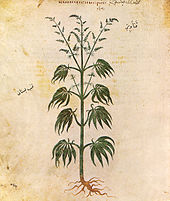 Cannabis sativa from Vienna Dioscurides, 512 AD
Cannabis sativa from Vienna Dioscurides, 512 AD
Cannabis has an ancient history of ritual use and is found in pharmacological cults around the world. Hemp seeds discovered by archaeologists at Pazyryk suggest early ceremonial practices like eating by the Scythians occurred during the 5th to 2nd century BC, confirming previous historical reports by Herodotus.[87] One writer has claimed that cannabis was used as a religious sacrament by ancient Jews and early Christians[6][88] due to the similarity between the Hebrew word "qannabbos" ("cannabis") and the Hebrew phrase "qené bósem" ("aromatic cane"). It was used by Muslims in various Sufi orders as early as the Mamluk period, for example by the Qalandars.[89]
A study published in the South African Journal of Science showed that "pipes dug up from the garden of Shakespeare's home in Stratford-upon-Avon contain traces of cannabis."[90] The chemical analysis was carried out after researchers hypothesized that the "noted weed" mentioned in Sonnet 76 and the "journey in my head" from Sonnet 27 could be references to cannabis and the use thereof.[91]
Cannabis was criminalized in various countries beginning in the early 20th century. In the United States, the first restrictions for sale of cannabis came in 1906 (in District of Columbia).[92] It was outlawed in South Africa in 1911, in Jamaica (then a British colony) in 1913, and in the United Kingdom and New Zealand in the 1920s.[93] Canada criminalized marijuana in the Opium and Drug Act of 1923, before any reports of use of the drug in Canada. In 1925 a compromise was made at an international conference in The Hague about the International Opium Convention that banned exportation of "Indian hemp" to countries that had prohibited its use, and requiring importing countries to issue certificates approving the importation and stating that the shipment was required "exclusively for medical or scientific purposes". It also required parties to "exercise an effective control of such a nature as to prevent the illicit international traffic in Indian hemp and especially in the resin".[94][95]
In 1937 in the United States, the Marijuana Transfer Tax Act was passed, and prohibited the production of hemp in addition to marijuana. The reasons that hemp was also included in this law are disputed. Several scholars have claimed that the Act was passed in order to destroy the hemp industry,[96][97][98] largely as an effort of businessmen Andrew Mellon, Randolph Hearst, and the Du Pont family.[96][98] With the invention of the decorticator, hemp became a very cheap substitute for the paper pulp that was used in the newspaper industry.[96][99] Hearst felt that this was a threat to his extensive timber holdings. Mellon, Secretary of the Treasury and the wealthiest man in America, had invested heavily in the DuPont's new synthetic fiber, nylon, and considered its success to depend on its replacement of the traditional resource, hemp.[96][100][101][102][103][104][105][106] The claims that hemp could have been a successful substitute for wood pulp have been based on an incorrect government report of 1916 which concluded that hemp hurds, broken parts of the inner core of the hemp stem, were a suitable source for paper production. This has not been confirmed by later research, as hemp hurds are not reported to be a good enough substitute. In 2003, 95 % of the hemp hurds in EU were used for animal bedding, almost 5 % were used as building material.[107][108][109][110] See also Hemp.
Legal status
Main article: Legality of cannabisSee also: Prohibition of drugs and Drug liberalizationSince the beginning of the 20th century, most countries have enacted laws against the cultivation, possession or transfer of cannabis. These laws have impacted adversely on the cannabis plant's cultivation for non-recreational purposes, but there are many regions where, under certain circumstances, handling of cannabis is legal or licensed. Many jurisdictions have lessened the penalties for possession of small quantities of cannabis, so that it is punished by confiscation and sometimes a fine, rather than imprisonment, focusing more on those who traffic the drug on the black market.
In some areas where cannabis use has been historically tolerated, some new restrictions have been put in place, such as the closing of cannabis coffee shops near the borders of the Netherlands,[111] closing of coffee shops near secondary schools in the Netherlands and crackdowns on "Pusher Street" in Christiania, Copenhagen in 2004.[112][113]
Some jurisdictions use free voluntary treatment programs and/or mandatory treatment programs for frequent known users. Simple possession can carry long prison terms in some countries, particularly in East Asia, where the sale of cannabis may lead to a sentence of life in prison or even execution. More recently however, many political parties, non-profit organizations and causes based on the legalization of medical cannabis and/or legalizing the plant entirely (with some restrictions) have emerged.
Price
The price or street value of cannabis varies strongly by region and area. In addition, some dealers may sell potent buds at a higher price.[114]
In the United States, cannabis is overall the #4 value crop, and is #1 or #2 in many states including California, New York and Florida, averaging $3,000/lb.[115][116] It is believed to generate an estimated $36 billion market.[117] Most of the money is spent not on growing and producing but on smuggling the supply to buyers. The United Nations Office on Drugs and Crime claims in its 2008 World Drug Report that typical U.S. retail prices are $10–15 per gram (approximately $280–420 per ounce). Street prices in North America are known to range from about $150 to $400 per ounce, depending on quality.[118]
The European Monitoring Centre for Drugs and Drug Addiction reports that typical retail prices in Europe for cannabis varies from 2€ to 14€ per gram, with a majority of European countries reporting prices in the range 4–10€.[119] In the United Kingdom, a cannabis plant has an approximate street value of £300,[120] but retails to the end-user at about £160/oz.
Truth serum
Cannabis was used as a truth serum by the Office of Strategic Services (OSS), a US government intelligence agency formed during World War II. In the early 1940s, it was the most effective truth drug developed at the OSS labs at St. Elizabeths Hospital; it caused a subject "to be loquacious and free in his impartation of information."[121]
In May 1943, Major George Hunter White, head of OSS counter-intelligence operations in the US, arranged a meeting with Augusto Del Gracio, an enforcer for gangster Lucky Luciano. Del Gracio was given cigarettes spiked with THC concentrate from cannabis, and subsequently talked openly about Luciano's heroin operation. On a second occasion the dosage was increased such that Del Gracio passed out for two hours.[121]
Breeding and cultivation
Main article: Cannabis cultivation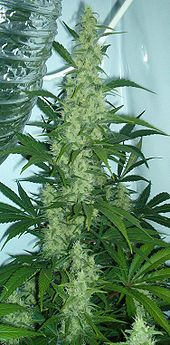 Maturing female Cannabis plant
Maturing female Cannabis plant
It is often claimed by growers and breeders of herbal cannabis that advances in breeding and cultivation techniques have increased the potency of cannabis since the late 1960s and early '70s, when THC was first discovered and understood. However, potent seedless marijuana such as "Thai sticks" were already available at that time. Sinsemilla (Spanish for "without seed") is the dried, seedless inflorescences of female cannabis plants. Because THC production drops off once pollination occurs, the male plants (which produce little THC themselves) are eliminated before they shed pollen to prevent pollination. Advanced cultivation techniques such as hydroponics, cloning, high-intensity artificial lighting, and the sea of green method are frequently employed as a response (in part) to prohibition enforcement efforts that make outdoor cultivation more risky. These intensive horticultural techniques have made it possible to grow strains with fewer seeds and higher potency.[citation needed] It is often cited that the average levels of THC in cannabis sold in United States rose dramatically between the 1970s and 2000, but such statements are likely skewed because of undue weight given to much more expensive and potent, but less prevalent samples.[122] The average THC level in coffee shops in the Netherlands is about 18–19%.[123]
In arts and literature
See also
- Addiction Recovery
- Cannabis plant
- Cannabis legality
- Cannabis political parties
- Global Marijuana March
- Legal and medical status of cannabis
- Legal history of cannabis in the United States
- Legality of cannabis by country
- Marihuana Tax Act of 1937
- Marijuana Control, Regulation, and Education Act
- Marijuana Policy Project
- National Organization for the Reform of Marijuana Laws
- Cannabis use demographics
Footnotes
^ a: Weed, pot, spliff, Mary Jane, grass, herb, schwag, and reefer, are among the many other nicknames for marijuana or cannabis as a drug.[124]
^ b: Sources for this section and more information can be found in the Medical cannabis articleCitations
- ^ a b John H. Wiersema. "Cannabis sativa information from NPGS/GRIN". Ars-grin.gov. http://www.ars-grin.gov/cgi-bin/npgs/html/taxon.pl?8862. Retrieved 2010-01-02.
- ^ See, Etymology of marijuana.
- ^ Company, Houghton Mifflin; American Heritage Dictionaries (2007-11-14). Spanish Word Histories and Mysteries. Houghton Mifflin Harcourt. p. 142. ISBN 0618910549, 9780618910540. http://books.google.com/?id=VTYBbGybtNEC&pg=PA142.
- ^ Shorter Oxford English Dictionary (6th ed.), Oxford University Press, 2007, ISBN 978-0-19-920687-2
- ^ UNODC. World Drug Report 2010. United Nations Publication. p. 198. http://www.unodc.org/unodc/en/data-and-analysis/WDR-2010.html. Retrieved 2010-07-19.
- ^ a b Matthew J. Atha (Independent Drug Monitoring Unit). "Types of Cannabis Available in the United Kingdom (UK)". http://www.idmu.co.uk/can.htm.
- ^ Fusar-Poli P, Crippa JA, Bhattacharyya S, et al. (January 2009). "Distinct effects of {delta}9-tetrahydrocannabinol and cannabidiol on neural activation during emotional processing". Archives of General Psychiatry 66 (1): 95–105. doi:10.1001/archgenpsychiatry.2008.519. PMID 19124693. http://archpsyc.ama-assn.org/cgi/pmidlookup?view=long&pmid=19124693. Retrieved 2009-09-26.
- ^ a b Rudgley, Richard (1998). Lost Civilisations of the Stone Age.. New York: Free Press. ISBN 0-6848-5580-1.
- ^ United Nations Office on Drugs and Crime (2006) (PDF). Cannabis: Why We Should Care.. 1. S.l.: United Nations. 14. ISBN 9-2114-8214-3. http://www.unodc.org/pdf/WDR_2006/wdr2006_chap2_biggest_market.pdf.
- ^ ""Cannabis: Legal Status"". Erowid.org. http://www.erowid.org/plants/cannabis/cannabis_law.shtml. Retrieved 2011-10-30.
- ^ "Marijuana and the Brain, Part II: The Tolerance Factor". http://www.marijuanalibrary.org/brain2.txt.
- ^ Riedel, G.; Davies, S.N. (2005). "Cannabinoid function in learning, memory and plasticity". Handb Exp Pharmacol. Handbook of Experimental Pharmacology 168 (168): 445–77. doi:10.1007/3-540-26573-2_15. ISBN 3-540-22565-X. PMID 16596784. http://www.springerlink.com/content/978-3-540-22565-2/#section=552817&page=2&locus=4. Retrieved 2010-12-15.
- ^ "Long-Term Effects of Exposure to Cannabis". Sciencedirect.com. http://www.sciencedirect.com/science?_ob=ArticleURL&_udi=B6W7F-4F2V4WS-1&_user=10&_rdoc=1&_fmt=&_orig=search&_sort=d&view=c&_acct=C000050221&_version=1&_urlVersion=0&_userid=10&md5=b92fd07057e46eea44d2a4ef5d33d744. Retrieved 2010-09-20.
- ^ "Adverse Effects of Cannabis on Health: An Update of the Literature Since 1996". Sciencedirect.com. http://www.sciencedirect.com/science?_ob=ArticleURL&_udi=B6TBR-4CY0JSM-2&_user=10&_rdoc=1&_fmt=&_orig=search&_sort=d&view=c&_acct=C000050221&_version=1&_urlVersion=0&_userid=10&md5=95a842fef02272cc8b862ad11cc89cb8. Retrieved 2010-09-20.
- ^ Stafford, Peter (1992). Psychedelics Encyclopedia.. Berkeley, California, United States: Ronin Publishing, Inc. ISBN 0914171518.
- ^ McKim, William A (2002). Drugs and Behavior: An Introduction to Behavioral Pharmacology (5th Edition).. Prentice Hall. p. 400. ISBN 0-13-048118-1.
- ^ "Information on Drugs of Abuse.". Commonly Abused Drug Chart. http://www.nida.nih.gov/DrugPages/DrugsofAbuse.html.
- ^ "Cannabis spray for MS: Controversial medicine that relieves pain gets go-ahead". June 22, 2011. http://www.dailymail.co.uk/health/article-1288409/Savitex-Cannabis-mouth-spray-MS-relieves-pain-gets-ahead.html.
- ^ Harris, G. (18 January 2010). "Researchers find study of medical marijuana discouraged". New York Times (New York). http://www.nytimes.com/2010/01/19/health/policy/19marijuana.html?hpw. Retrieved 19 January 2010.
- ^ "Medical Frequently Asked Questions". NORML. http://norml.org/index.cfm?Group_ID=3387. Retrieved 2010-01-02.
- ^ "FDA: Inter-Agency Advisory Regarding Claims That Smoked Marijuana Is a Medicine". Fda.gov. http://www.fda.gov/NewsEvents/Newsroom/PressAnnouncements/2006/ucm108643.htm. Retrieved 2010-09-20.
- ^ "Frequently Asked Questions - Medical Marihuana". Hc-sc.gc.ca. http://www.hc-sc.gc.ca/dhp-mps/marihuana/about-apropos/faq-eng.php. Retrieved 2010-01-02.
- ^ Nutt, D.; King, L. A.; Saulsbury, W.; Blakemore, C. (2007). "Development of a rational scale to assess the harm of drugs of potential misuse". The Lancet 369 (9566): 1047–1053. doi:10.1016/S0140-6736(07)60464-4. PMID 17382831.
- ^ McLaren, Jennifer; Lemon, Jim; Robins, Lisa; Mattick, Richard P. (February 2008). Cannabis and Mental Health: Put into Context. National Drug Strategy Monograph Series. Australian Government Department of Health and Ageing. http://ncpic.org.au/ncpic/news/ncpic-news/article/new-national-drug-strategy-monograph-series-report-cannabis-and-mental-health-put-into-context. Retrieved 17 October 2009.
- ^ Henquet, C.; Krabbendam, L.; Spauwen, J.; Kaplan, C.; Lieb, R.; Wittchen, H. -U.; Van Os, J. (2005). "Prospective cohort study of cannabis use, predisposition for psychosis, and psychotic symptoms in young people". BMJ 330 (7481): 11. doi:10.1136/bmj.38267.664086.63. PMC 539839. PMID 15574485. http://www.pubmedcentral.nih.gov/articlerender.fcgi?tool=pmcentrez&artid=539839.
- ^ Patton, G. C., Coffey, C., Carlin, J. B., Degenhardt, L., Lynskey, M., and Hall, W. 2002. Cannabis use and mental health in young people: cohort study. BMJ 325(7374): 1195-1198. Retrieved 45 March 2007
- ^ Simeon, Daphne (2004). "Depersonalization Disorder: A Contemporary Overview". CNS Drugs. http://www.ncbi.nlm.nih.gov/pubmed/15089102. Retrieved 11/11/2011.
- ^ Szymanski, HV (February 1981). "Prolonged depersonalization after marijuana use". Am J Psychiatry: 231-233.
- ^ Keshaven, MS; Lishman, WA (February 1986). "Prolonged depersonalization following cannabis abuse". Br J Addict: 140-142.
- ^ Simeon, Daphne; Knutelska M, Nelson D, et al. (2003). "Feeling unreal: a depersonalization disorder update of 117 cases". J Clin Psychiatry: 990-997.
- ^ Medford, Nick; Sierra M, Baker D, David A (2005). "Understanding and treating depersonalization disorder". Adv. Psychiatr. Treat.: 92-100. http://apt.rcpsych.org/content/11/2/92.full. Retrieved 11/11/2011.
- ^ "High Times in Ag Science: Marijuana More Potent Than Ever | Wired Science". Wired.com. 2008-12-22. http://www.wired.com/wiredscience/2008/12/high-times-in-a/. Retrieved 2010-01-02.
- ^ "Marijuana- Definitions from Dictionary.com". dictionary.reference.com. http://dictionary.reference.com/browse/Marijuana.
- ^ "Hemp Facts". Naihc.org. http://www.naihc.org/hemp_information/hemp_facts.html. Retrieved 2010-01-02.
- ^ "Kief | Cannabis Culture Magazine". Cannabisculture.com. http://www.cannabisculture.com/v2/articles/4220.html. Retrieved 2010-01-02.
- ^ "Hashish - Definitions from Dictionary.com". dictionary.reference.com. http://dictionary.reference.com/browse/Hashish.
- ^ "Hash Oil Info.". http://www.a1b2c3.com/drugs/hash005.htm.
- ^ "Pipe Residue Information.". http://www.cannabisculture.com/v2/articles/3603.html.
- ^ "ChemSpider - THC". http://www.chemspider.com/Chemical-Structure.15266.html.
- ^ "ChemSpider - Cannabinol". http://www.chemspider.com/Chemical-Structure.2447.html.
- ^ "Decarboxylation - Does Marijuana Have to be Heated to Become Psychoactive?". http://www.cannabisculture.com/articles/2794.html.
- ^ Dronabinol in the ChemIDplus database
- ^ Leo E. Hollister, et al. (March 1986). "Health aspects of cannabis". Pharma Review (38): 1–20. Archived from the original on 1986. http://www.druglibrary.org/Schaffer/hemp/medical/hollisterhealth.htm. Retrieved 2011-02-17.
- ^ Wilson, R. & Nicoll, A. (2002). "Endocannabinoid signaling in the brain". Science 296 (5568): 678–682. doi:10.1126/science.1063545. PMID 11976437.
- ^ Fernandez, J. & Allison, B. (2004). "Rimbonabant Sanofi-Synthelabo". Current Opinion in Investigational Drugs (5): 430–435.
- ^ a b c "Why Does Cannabis Potency Matter?". United Nations Office on Drugs and Crime. 2009-06-29. http://www.unodc.org/unodc/en/frontpage/2009/June/why-does-cannabis-potency-matter.html.
- ^ ElSohly MA, Ross SA, Mehmedic Z, Arafat R, Yi B, Banahan BF (January 2000). "Potency Trends of delta9-THC and Other Cannabinoids in Confiscated Marijuana from 1980 to 1997". Journal of Forensic Sciences 45 (1): 24–30. PMID 10641915.
- ^ Olemiss.edu[dead link]
- ^ "Cannabis Potency.". National Cannabis Prevention and Information Centre. Archived from the original on 2008-07-20. http://web.archive.org/web/20080720080757/http://ncpic.org.au/workforce/cannabisinfo/factsheets/article/cannabis-potency.
- ^ "BBC: Cannabis laws to be strengthened. May 2008 20:55 UK". BBC News. 2008-05-07. http://news.bbc.co.uk/1/hi/uk_politics/7386889.stm. Retrieved 2010-09-20.
- ^ Di Forti, M; Morgan, C; Dazzan, P; Pariante, C; Mondelli, V; Marques, TR; Handley, R; Luzi, S et al.. "High-potency cannabis and the risk of psychosis". British Journal of Psychiatry (Bjp.rcpsych.org) 195 (6): 488–91. doi:10.1192/bjp.bp.109.064220. PMC 2801827. PMID 19949195. http://bjp.rcpsych.org/cgi/content/abstract/195/6/488. Retrieved 2010-01-02.
- ^ Hope, Christopher (2008-02-06). "Use of extra strong 'skunk' cannabis soars". The Daily Telegraph (London). http://www.telegraph.co.uk/news/uknews/1577798/Use-of-extra-strong-skunk-cannabis-soars.html.
- ^ "Electronenmicroscopisch onderzoek van vervuilde wietmonsters". http://www.rivm.nl/bibliotheek/digitaaldepot/BriefrapportWiet.pdf.
- ^ "Department of Health, Social Services and Public Safety - Contamination of herbal or 'skunk-type' cannabis with glass beads". http://www.dhsspsni.gov.uk/hss_md_3-2007.pdf.
- ^ "Department of Health, Social Services and Public Safety - Update on seizures of cannabis contaminated with glass particles". http://www.dhsspsni.gov.uk/hss_md_11-2007__update.pdf.
- ^ Busse F, Omidi L, Timper K, et al. (April 2008). "Lead poisoning due to adulterated marijuana". N. Engl. J. Med. 358 (15): 1641–2. doi:10.1056/NEJMc0707784. PMID 18403778.
- ^ Venhuis BJ, de Kaste D (November 2008). "Sildenafil analogs used for adulterating marijuana". Forensic Sci. Int. 182 (1–3): e23–4. doi:10.1016/j.forsciint.2008.09.002. PMID 18945564.
- ^ "FRANK - Cannabis". Talktofrank.com. http://www.talktofrank.com/drugs.aspx?id=172. Retrieved 2010-01-02.
- ^ "UKCIA Soapbar warning - cannabis conamination - don't buy soapbar!". Ukcia.org. http://www.ukcia.org/activism/soapbar.php. Retrieved 2010-01-02.
- ^ "Feature - Dr Russell Newcome on the ACMD report on cannabis : 2006-02-07". Lifeline Project. 2006-02-07. http://www.lifelineproject.co.uk/Dr-Russell-Newcome-on-the-ACMD-report-on-cannabis_25.php. Retrieved 2010-01-02.
- ^ a b R. Baselt, Disposition of Toxic Drugs and Chemicals in Man, 8th edition, Biomedical Publications, Foster City, CA, 2008, pp 1513–1518.
- ^ Coulter C, Taruc M, Tuyay J, Moore C. Quantitation of tetrahydrocannabinol in hair using immunoassay and liquid chromatography with tandem mass spectrometric detection. Drug Test. Anal. 1: 234–239, 2009.
- ^ DM Schwope, G Milman and MA Huestis. Validation of an enzyme immunoassay for detection and semiquantification of cannabinoids in oral fluid. Clin. Chem. 56: 1007–1014, 2010.
- ^ Huestis MA, Scheidweiler KB, Saito T, Fortner N, Abraham T, Gustafson RA, Smith ML (2008). "Excretion of Δ9-Tetrahydrocannabinol in Sweat". Forensic Sci. Int. 174 (2–3): 173–177. doi:10.1016/j.forsciint.2007.04.002. PMC 2277330. PMID 17481836. http://www.pubmedcentral.nih.gov/articlerender.fcgi?tool=pmcentrez&artid=2277330.
- ^ AlterNet, 28 July 2010, Has the Most Common Marijuana Test Resulted in Tens of Thousands of Wrongful Convictions?
- ^ Lundin, Leigh (2009-03-01). "The Great Smoke-Out". Criminal Brief. http://www.criminalbrief.com/?p=5445.
- ^ a b "RAND study casts doubt on claims that marijuana acts as "gateway" to the use of cocaine and heroin". RAND Corporation. 2002-12-02. Archived from the original on 2006-11-04. http://web.archive.org/web/20061104124529/http://www.rand.org/news/press.02/gateway.html.
- ^ a b Torabi MR, Bailey WJ, Majd-Jabbari M (1993). "Cigarette Smoking as a Predictor of Alcohol and Other Drug Use by Children and Adolescents: Evidence of the "Gateway Drug Effect"". The Journal of School Health 63 (7): 302–306. doi:10.1111/j.1746-1561.1993.tb06150.x. PMID 8246462.
- ^ Australian Government Department of Health: National Cannabis Strategy Consultation Paper, p. 4. "Cannabis has been described as a 'Trojan Horse' for nicotine addiction, given the usual method of mixing Cannabis with tobacco when preparing marijuana for administration."
- ^ Hall WD, Lynskey M (January 2005). "Is Cannabis A Gateway Drug? Testing Hypotheses About the Relationship Between Cannabis Use and the Use of Other Illicit Drugs". Drug and Alcohol Review 24 (1): 39–48. doi:10.1080/09595230500126698. PMID 16191720. http://www.informaworld.com/openurl?genre=article&doi=10.1080/09595230500126698&magic=pubmed%7C%7C1B69BA326FFE69C3F0A8F227DF8201D0.
- ^ Saitz, Richard (2003-02-18). "Is marijuana a gateway drug?". Journal Watch 2003 (218): 1. http://general-medicine.jwatch.org/cgi/content/full/2003/218/1.
- ^ Degenhardt, Louisa et al. (2007). "Who are the new amphetamine users? A 10-year prospective study of young Australians". http://www.blackwell-synergy.com/doi/abs/10.1111/j.1360-0443.2007.01906.x.
- ^ Morral AR, McCaffrey DF, Paddock SM (2002). "Reassessing the marijuana gateway effect". Addiction 97 (12): 1493–504. doi:10.1046/j.1360-0443.2002.00280.x. PMID 12472629. http://www3.interscience.wiley.com/journal/118957921/abstract.
- ^ "Marijuana Policy Project- FAQ". Archived from the original on 2008-06-22. http://web.archive.org/web/20080622204803/http://www.mpp.org/about/faq.html.
- ^ "Risk of marijuana's 'gateway effect' overblown, new research shows". Sciencedaily.com. 2010-09-02. http://www.sciencedaily.com/releases/2010/09/100902073507.htm. Retrieved 2010-09-20.
- ^ Stafford, Peter (1992). Psychedelics Encyclopedia. Berkeley, CA, USA: Ronin Publishing. ISBN 0-914171-51-8. http://books.google.com/?id=Ec5hNgYWHtkC&printsec=frontcover.
- ^ Matthews, A; Matthews, L (2007). Learning Chinese Characters. p. 336. ISBN 9780804838160. http://books.google.com/?id=YweFHwPd05EC&pg=PA336&lpg=PA336&dq=hemp+wood+shelter.
- ^ "Marijuana and the Cannabinoids", ElSohly (p. 8).
- ^ "Lab work to identify 2,800-year-old mummy of shaman". People's Daily Online. 2006. http://english.peopledaily.com.cn/200612/23/eng20061223_335258.html.
- ^ Hong-En Jiang et al (2006). "A new insight into Cannabis sativa (Cannabaceae) utilization from 2500-year-old Yanghai tombs, Xinjiang, China". Journal of Ethnopharmacology 108 (3): 414–22. doi:10.1016/j.jep.2006.05.034. PMID 16879937. http://www.sciencedirect.com/science?_ob=ArticleURL&_udi=B6T8D-4K7WC0F-2&_user=10&_coverDate=12%2F06%2F2006&_rdoc=17&_fmt=summary&_orig=browse&_srch=doc-info(%23toc%235084%232006%23998919996%23636769%23FLA%23display%23Volume)&_cdi=5084&_sort=d&_docanchor=&view=c&_ct=23&_acct=C000050221&_version=1&_urlVersion=0&_userid=10&md5=3e6ac8940b4b86b94935cd7a7d7bc19d.
- ^ Leary, Thimothy (1990). Tarcher & Putnam. ed. Flashbacks. New York: GP Putnam's Sons. ISBN 0-8747-7870-0.
- ^ Miller, Ga (1911). Encyclopædia Britannica. 34 (11th ed.). 761–2. doi:10.1126/science.34.883.761. PMID 17759460. http://www.1911encyclopedia.org/Hemp.
- ^ Rudgley, Richard (1998). Little, Brown, et al. ed. The Encyclopedia of Psychoactive Substances. ISBN 0349111278. http://www.huxley.net/soma/index.html.
- ^ Franck, Mel (1997). Marijuana Grower's Guide. Red Eye Press. p. 3. ISBN 0-9293-4903-2.
- ^ Rubin, Vera D (1976). Cannabis and Culture. Campus Verlag. p. 305. ISBN 3-5933-7442-0.
- ^ Cunliffe, Barry W (2001). The Oxford Illustrated History of Prehistoric Europe. Oxford University Press. p. 405. ISBN 0-1928-5441-0.
- ^ Walton, Robert P (1938). Marijuana, America's New Drug Problem. JB Lippincott. p. 6.
- ^ "Cannabis linked to Biblical healing". News (BBC). 2003-01-06. http://news.bbc.co.uk/2/hi/health/2633187.stm. Retrieved 2009-12-31.
- ^ Ibn Taymiyya (2001) (in FR). Le haschich et l'extase. Beyrouth: Albouraq. ISBN 2-8416-1174-4.
- ^ "Bard 'used drugs for inspiration'". BBC News (BBC). 2001-03-01. http://news.bbc.co.uk/2/hi/entertainment/1195939.stm. Retrieved 2009-08-07.
- ^ "Drugs clue to Shakespeare's genius". CNN (Turner Broadcasting System). 2001-03-01. http://edition.cnn.com/2001/WORLD/europe/UK/03/01/shakespeare.cannabis/. Retrieved 2009-08-07.
- ^ "Statement of Dr. William C. Woodward". Drug library. http://www.druglibrary.org/schaffer/hemp/taxact/woodward.htm. Retrieved 2010-09-20.
- ^ "Debunking the Hemp Conspiracy Theory". http://www.alternet.org/drugreporter/77339/?page=entire.
- ^ W. W. Willoughby (1925). "Opium as an international problem". Baltimore: The Johns Hopkins Press. http://www.druglibrary.org/schaffer/history/e1920/willoughby.htm. Retrieved 2010-09-20.
- ^ Opium as an international problem: the Geneva conferences – Westel Woodbury Willoughby at Google Books
- ^ a b c d French, Laurence; Manzanárez, Magdaleno (2004). NAFTA & neocolonialism: comparative criminal, human & social justice. University Press of America. p. 129. ISBN 9780761828907. http://books.google.com/?id=4ozF1Yg-c4MC&pg=PA129.
- ^ Earlywine, 2005: p. 24
- ^ a b Peet, 2004: p. 55
- ^ Sterling Evans (2007). Bound in twine: the history and ecology of the henequen-wheat complex for Mexico and the American and Canadian Plains, 1880–1950. Texas A&M University Press. p. 27. ISBN 9781585445967. http://books.google.com/books?id=_wFkZgyuGFAC&pg=PA27.
- ^ Evans, Sterling, ed (2006). The borderlands of the American and Canadian Wests: essays on regional history of the forty-ninth parallel. University of Nebraska Press. p. 199. ISBN 9780803218260. http://books.google.com/books?id=xBELvIaDXxAC&pg=PA199.
- ^ Gerber, Rudolph Joseph (2004). Legalizing marijuana: drug policy reform and prohibition politics. Greenwood Publishing Group. p. 7. ISBN 9780275974480. http://books.google.com/books?id=WMOdI9pC-gEC&pg=PA7.
- ^ Earleywine, Mitchell (2005). Understanding marijuana: a new look at the scientific evidence. Oxford University Press. p. 231. ISBN 9780195182958. http://books.google.com/books?id=r9wPbxMAG8cC&pg=PA231.
- ^ Robinson, Matthew B & Scherlen, Renee G (2007). Lies, damned lies, and drug war statistics: a critical analysis of claims made by the office of National Drug Control Policy. SUNY Press. p. 12. ISBN 9780791469750. http://books.google.com/books?id=dwGpsNjv_1kC&pg=PA12.
- ^ Rowe, Thomas C (2006). Federal narcotics laws and the war on drugs: money down a rat hole. Psychology Press. p. 26. ISBN 9780789028082. http://books.google.com/books?id=v1tz6nP6fdwC&pg=PA26.
- ^ Sullivan, Larry E et al, ed (2005). Encyclopedia of Law Enforcement: Federal. SAGE. p. 747. ISBN 9780761926498. http://books.google.com/books?id=FtgYAAAAIAAJ&q=hearst+hemp&dq=hearst+hemp.
- ^ Lusane, Clarence (1991). Pipe dream blues: racism and the war on drugs. South End Press. pp. 37–8. ISBN 9780896084100. http://books.google.com/books?id=flIjcQBwu68C&pg=PA37.
- ^ Lyster H. Dewey and Jason L. Merrill Hemp Hurds as Paper-Making Material USDA Bulletin No. 404, Washington, DC, October 14, 1916, p. 25.
- ^ "Hayo MG van der Werf: Hemp facts and hemp fiction". Hempfood.com. http://www.hempfood.com/iha/iha01213.html. Retrieved 2011-10-30.
- ^ "Dr. Ivan BÛcsa, GATE Agricultural Research Institute, Kompolt — Hungary, Book Review Re-discovery of the Crop Plant Cannabis Marihuana Hemp (Die Wiederentdeckung der Nutzplanze Cannabis Marihuana Hanf)". Hempfood.com. http://www.hempfood.com/iha/iha01214.html. Retrieved 2011-10-30.
- ^ Michael Karus: European Hemp Industry 2002 Cultivation, Processing and Product Lines. Journal of Industrial Hemp Volume 9 Issue 2 2004, Taylor & Francis, London.
- ^ "Many Dutch coffee shops close as liberal policies change, Exaptica". Expatica.com. 2007-11-27. http://www.expatica.com/nl/leisure/arts_culture/many-dutch-coffee-shops-close-as-liberal-policies-change-46376.html. Retrieved 2010-09-20.
- ^ EMCDDA Cannabis reader: Global issues and local experiences, Perspectives on Cannabis controversies, treatment and regulation in Europe, 2008, p. 157.
- ^ "43 Amsterdam coffee shops to close door", Radio Netherlands, Friday 21 November 2008[dead link]
- ^ "UNODC.org" (PDF). http://www.unodc.org/pdf/WDR_2005/volume_2_chap7_cannabis.pdf. Retrieved 2010-09-20.
- ^ "Report on U.S. Domestic Marijuana Production". NORML. http://norml.org/index.cfm?Group_ID=4444. Retrieved 2010-01-02.
- ^ "Marijuana Crop Reports". NORML. http://norml.org/index.cfm?Group_ID=4414. Retrieved 2010-01-02.
- ^ "Marijuana Called Top U.S. Cash Crop". 2008 ABCNews Internet Ventures. http://abcnews.go.com/business/story?id=2735017&page=1.
- ^ United Nations Office on Drugs and Crime (2008) (PDF). World drug report. United Nations Publications. p. 264. ISBN 978-92-1-148229-4. http://www.unodc.org/documents/wdr/WDR_2008/WDR_2008_eng_web.pdf.
- ^ European Monitoring Centre for Drugs and Drug Addiction (2008) (PDF). Annual report: the state of the drugs problem in Europe. Luxembourg: Office for Official Publications of the European Communities. p. 38. ISBN 978-92-9168-324-6. http://www.emcdda.europa.eu/attachements.cfm/att_64227_EN_EMCDDA_AR08_en.pdf.
- ^ Dearne Safer Neighbourhood Team (SNT) recovers cannabis with a street value of approximately £9,000
- ^ a b Cockburn, Alexander; Jeffrey St. Clair (1998). Whiteout: The CIA, Drugs and the Press. Verso. pp. 117–118. ISBN 1859841392. http://books.google.com/?id=s5qIj_h_PtkC&printsec=frontcover#PPA118,M1.
- ^ Daniel Forbes (November 19, 2002). "The Myth of Potent Pot". Slate.com. http://www.slate.com/id/2074151.
- ^ "World Drug Report 2006". United Nations Office on Drugs and Crime. http://www.unodc.org/unodc/en/data-and-analysis/WDR-2006.html. Ch. 2.3.
- ^ "Marijuana Dictionary". http://www.marijuanadictionary.com/.
Further reading
- Booth, Martin (2005). Cannabis: A History. Macmillan Publishers & Random House, Inc. ISBN 978-0-312-42494-7.
- Deitch, Robert (2003). Hemp: American history revisited: the plant with a divided history. Algora Pub. ISBN 0875862063. http://books.google.ca/books?id=PKDrpeRRY94C&lpg=PA9&dq=History%20of%20Cannabis&pg=PP1#v=onepage&q&f=true
- Earleywine, Mitchell (2005). Understanding marijuana: a new look at the scientific evidence. Oxford University Press. ISBN 0195138937. http://books.google.ca/books?id=r9wPbxMAG8cC&lpg=PA3&dq=History%20of%20Cannabis&pg=PP1#v=onepage&q&f=true
- Emmett, David; Graeme Nice (2009). What you need to know about cannabis: understanding the facts. Jessica Kingsley Publishers. ISBN 1843106973. http://books.google.ca/books?id=dHAy6T_LSV4C&lpg=PA55&dq=History%20of%20Cannabis&pg=PP1#v=onepage&q&f=true
- Geoffrey William, Guy; Brian Anthony Whittle, Philip Robson (2004). The medicinal uses of cannabis and cannabinoids. Pharmaceutical Press. ISBN 0853695172. http://books.google.ca/books?id=AznCzOxvrtwC&lpg=PA1&dq=History%20of%20Cannabis&pg=PP1#v=onepage&q&f=true
- Holland, Julie M.D. (2010). The pot book : a complete guide to cannabis : its role in medicine, politics, science, and culture. Park Street Press. ISBN 9781594773686. http://books.google.ca/books?id=MQql_gt2QEgC&lpg=PA316&dq=Cannabis&pg=PP1#v=onepage&q&f=true
- Iversen, Leslie L (2008). The science of marijuana (2nd ed.). Oxford University Press. ISBN 9780195328240. http://books.google.ca/books?id=l8O2OMNLNtcC&lpg=PA17&dq=History%20of%20Cannabis&pg=PP1#v=onepage&q&f=true
- Jenkins, Richard (2006). Cannabis and young people: reviewing the evidence. Jessica Kingsley. ISBN 1843103982. http://books.google.ca/books?id=bFDznfmJLnAC&lpg=PP1&dq=Cannabis&pg=PP1#v=onepage&q&f=true
- Lambert, Didier M (2008). Cannabinoids in Nature and Medicine. Wiley-VCH. ISBN 390639056X. http://books.google.ca/books?id=ATDRt1HM9MwC&lpg=PA15&dq=History%20of%20Cannabis&pg=PR11#v=onepage&q&f=true
- Roffman, Roger A; Robert S. Stephens (2006). Cannabis dependence: its nature, consequences, and treatment. Cambridge University Press. ISBN 0521814472. http://books.google.ca/books?id=DEWRoPweosEC&lpg=PA89&dq=History%20of%20Cannabis&pg=PP1#v=onepage&q&f=true
- Russo, Ethan; Melanie Creagan Dreher, Mary Lynn Mathre (2004). Women and cannabis: medicine, science, and sociology. Haworth Press. ISBN 0789021013. http://books.google.ca/books?id=gZJ7m3Uf6FQC&lpg=PA29&dq=History%20of%20Cannabis&pg=PP1#v=onepage&q&f=true
- Solowij, Nadia (1998). Cannabis and cognitive functioning. Cambridge University Press. ISBN 0521591147. http://books.google.ca/books?id=bL2u5RRYIpcC&lpg=PA84&dq=History%20of%20Cannabis&pg=PP1#v=onepage&q&f=true
External links
 Media related to Cannabis at Wikimedia Commons
Media related to Cannabis at Wikimedia Commons- Wiktionary Appendix of Cannabis Slang
- Montana PBS documentary,Clearing the Smoke
- Erowid Cannabis (Marijuana) Vault
- Reefer Madness! - slideshow by Life magazine
- "Cannabis: a health perspective and research agenda", Programme on Substance Abuse, World Health Organization, 1997
- "Endocannabinoids Inhibit Transmission at Granule Cell to Purkinje Cell Synapses by Modulating Three Types of Presynaptic Calcium Channels"
Cannabis General Preparations Usage Effects Short-term · Long-term (dependence · withdrawal · respiratory disease) · Cannabidiol · Cannabinoids · Delta-9-tetrahydrocannabinol (Δ9-THC) · Endocannabinoid systemNotable strains Acapulco Gold · BC Bud · Holland's Hope · G-13 · Kush · Netherlands Weed · Northern Lights · Panama Red · Quebec Gold · Skunk · White WidowOrganizations Culture Cannabis portal Cannabinoids Plant cannabinoids Cannabinoid metabolites 8,11-DiOH-THC · 11-COOH-THC · 11-OH-THC
Endogenous cannabinoids Arachidonoyl ethanolamide (Anandamide or AEA) · 2-Arachidonoylglycerol (2-AG) · 2-Arachidonyl glyceryl ether (noladin ether) · Virodhamine · Palmitoylethanolamide (PEA) · N-Arachidonoyl dopamine (NADA) · Oleamide · RVD-Hpα
Synthetic cannabinoid
receptor agonistsClassical cannabinoids
(Dibenzopyrans)A-40174 · A-41988 · A-42574 · Ajulemic acid · AM-087 · AM-411 · AM-855 · AM-905 · AM-906 · AM-919 · AM-926 · AM-938 · AM-4030 · AMG-1 · AMG-3 · AMG-36 · AMG-41 · Dexanabinol (HU-211) · DMHP · Dronabinol · HHC · HU-210 · JWH-051 · JWH-133 · JWH-139 · JWH-161 · JWH-229 · JWH-359 · KM-233 · L-759,633 · L-759,656 · Levonantradol (CP 50,5561) · Nabazenil · Nabidrox (Canbisol) · Nabilone · Nabitan · Naboctate · O-581 · O-774 · O-806 · O-823 · O-1057 · O-1125 · O-1238 · O-2365 · O-2372 · O-2373 · O-2383 · O-2426 · O-2484 · O-2545 · O-2694 · O-2715 · O-2716 · O-3223 · O-3226 · Parahexyl · Perrottetinene · Pirnabine · THC-O-acetate · THC-O-phosphate
Nonclassical cannabinoidsBenzoylindoles1-Butyl-3-(2-methoxybenzoyl)indole · 1-Butyl-3-(4-methoxybenzoyl)indole · 1-Pentyl-3-(2-methoxybenzoyl)indole · AM-630 · AM-679 · AM-694 · AM-1241 · AM-2233 · GW-405,833 (L-768,242) · Pravadoline · RCS-4 · WIN 54,461
NaphthoylindolesNaphthylmethylindolesJWH-175 · JWH-184 · JWH-185 · JWH-192 · JWH-194 · JWH-195 · JWH-196 · JWH-197 · JWH-199
PhenylacetylindolesCannabipiperidiethanone · JWH-167 · JWH-203 · JWH-249 · JWH-250 · JWH-251 · JWH-302 · RCS-8
NaphthoylpyrrolesEicosanoidsAM-883 · Arachidonyl-2'-chloroethylamide (ACEA) · Arachidonylcyclopropylamide (ACPA) · Methanandamide (AM-356) · O-585 · O-689 · O-1812 · O-1860 · O-1861
Others(1-Pentylindol-3-yl)-(2,2,3,3-tetramethylcyclopropyl)methanone · N-(S)-Fenchyl-1-(2-morpholinoethyl)-7-methoxyindole-3-carboxamide · A-796,260 · A-834,735 · A-836,339 · Abnormal cannabidiol · AB-001 · AM-1248 · AZ-11713908 · BAY 38-7271 · BAY 59-3074 · CB-13 · CB-86 · GW-842,166X · JWH-171 · JWH-176 · JTE 7-31 · Leelamine · MDA-19 · O-1918 · O-2220 · Org 28312 · Org 28611 · SER-601 · VSN-16 · WIN 56,098
Allosteric modulators of
cannabinoid receptorsOrg 27569 · Org 27759 · Org 29647
Endocannabinoid
activity enhancersAM-404 · CAY-10401 · CAY-10429 · JZL184 · JZL195 · N-arachidonoyl-serotonin · O-1624 · PF-04457845 · PF-622 · PF-750 · PF-3845 · PHOP · URB-447 · URB-597 · URB-602 · URB-754 · Genistein · Arvanil · Olvanil · Kaempferol · Biochanin A
Cannabinoid receptor
antagonists and
inverse agonistsAM-251 · AM-281 · AM-630 · BML-190 · CAY-10508 · CB-25 · CB-52 · CB-86 · Drinabant · Hemopressin · Ibipinabant (SLV319) · JTE-907 · LY-320,135 · Taranabant (MK-0364) · MK-9470 · NESS-0327 · O-1184 · O-1248 · O-2050 · O-2654 · Otenabant · Rimonabant (SR141716) · SR144528 · Surinabant (SR147778) · TM-38837 · VCHSR
Categories:- Cannabis
- Cannabis smoking
- Entheogens
- Euphoriants
- Psychedelics, dissociatives and deliriants
Wikimedia Foundation. 2010.

